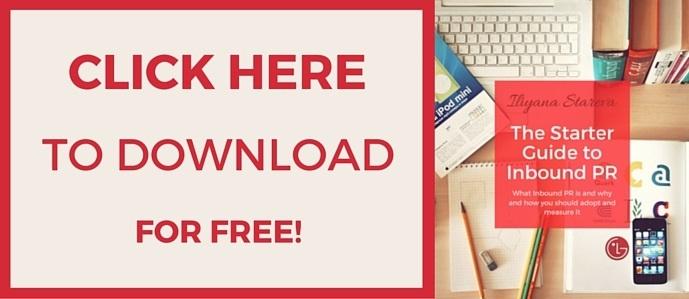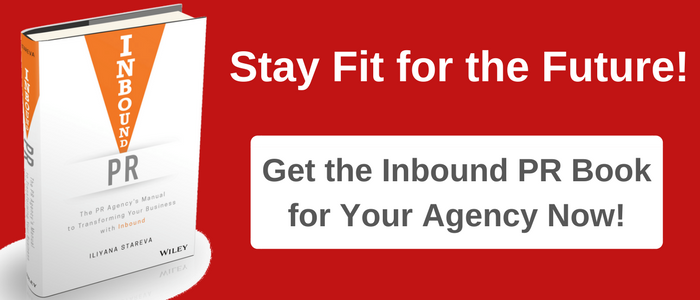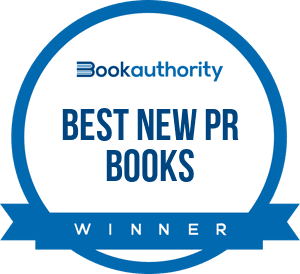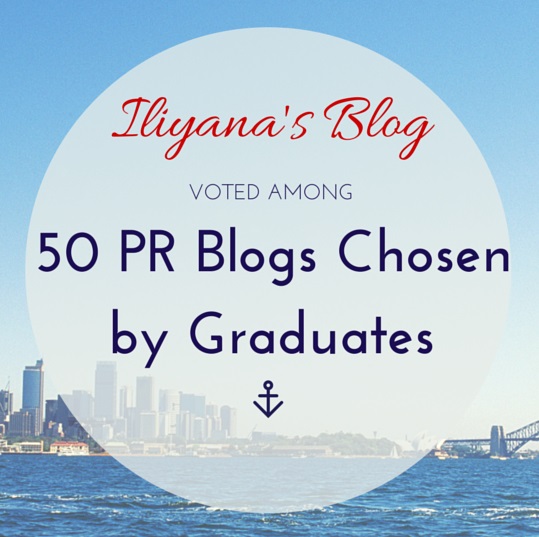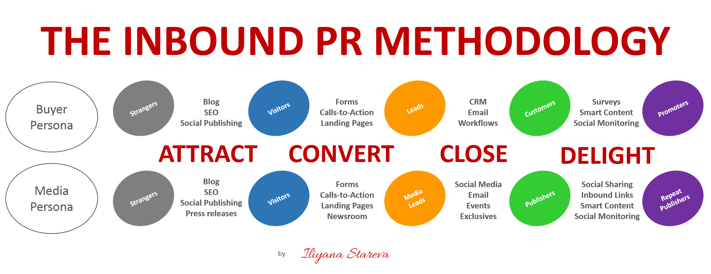
It's been a little over a year since I started writing about Inbound PR and introduced the concept.
Now that the idea has spread and seems to be gaining popularity, it's time to put a framework around it.
Today, I want to introduce you to the Inbound PR Methodology that visualises how Inbound PR relates to inbound marketing and how it differs from it. It captures how Inbound PR is all about targeted and relevant content being measured throughout the way to make smart and purposeful decisions.
Before we dig into the specifics of the new framework, I'd like to go over a few things around modern PR.
We all know how much our day-to-day life has changed since the Internet and thanks to the massive evolution in technology. With the digital embrace, the media had to adopt too. We now see four different types of media that the PESO model explains really well:
- Paid - sponsored social media posts and content, affiliates, native advertising etc.
- Earned - media relations, blogger and influencer relations, investor relations etc.
- Shared - social media, co-branding, community service, partnerships etc.
- Owned - employee stories, customer stories, UGC, webinars, videos, podcasts etc.
You see, Inbound PR is heavily focused on Owned media - doing your own PR with your own content on your own channels. It's pretty much fully adopting the inbound marketing methodology but excelling at the content creation part because this is what PR people do best - they create remarkable content because they are storytellers at heart.
Too Many Stakeholders in the Egosystem
But what's interesting about PR is that unlike marketing it has touch points with absolutely every stakeholder of a company. PR not only interacts with buyers but also the media, investors, employees, vendors, suppliers, society, communities, NGOs and more.
On top of that, each and one of those interest groups are now influencers. Regular people are influencers who have the power over a brand because we use our devices and our constant internet connection with the world to share our experiences at any time with the potential of them spreading throughout our networks.
And we believe that that's our right. Because as Brian Solis says, we now live in an egosystem where modern technology teaches us we are the most important person in our universe and it so makes us accidental narcissists.
Here's the catch, of course - the media, the bloggers and the influencers are all just people too, like buyers. They all have different ways of learning, reading, writing, researching and they've all changed with the digital revolution. They're all narcissists as well caring about their own agenda and having the power to choose what to consume or work on at any point as well as what to completely ignore.
Outbound PR vs. Inbound PR
Just as inbound has evolved in the way it reaches buyers - through pull rather than push - so that the way PR does Earned needs to evolve too.
Because traditional PR that is so strongly linked to media relations the outbound way - with cold calling and mass press release emails - needs to turn inbound.
Outbound PR interrupts. Inbound PR attracts and it attracts with the right content on the right channel promoted in the right way to the right media outlet, journalists, blogger or influencer at the right time.
Here's where the Inbound PR Methodology comes in place. You'll see in the graph below how it's divided into two parts - one covers the buyer persona, the other one the media persona.
As mentioned, PR in general works with more or less every stakeholder of a company so the principals of the Inbound PR Methodology can be applied to every one of them, not just buyers and the media/influencers.
Framework for The Inbound PR Methodology

For the sake of not overcomplicating it and because inbound itself explains how modern communications need to be reaching the buyers, I want to focus today on the media persona and how the methodology works there.
The Persona at the Centre of Inbound PR
Now as with anything content or digital related, we need to know who we are doing this for. One of my most important mottos is "Always do your research". Just as you define your buyer persona (or ideal customer or target audience or whatever you call it), you need to spend time defining your media persona in order to then generate not just any coverage but the right coverage that's going to be relevant to your brand or business.
Within media persona I include journalists, bloggers, influencers, basically everyone who is involved in Earned so below I'll be using just media for all those.
To define your media persona, you need to ask some questions:
- Which are the relevant media outlets for our business?
- Who are the journalists, bloggers, YouTubers etc that have an interested in us?
- Who are they and what are they like (demographic information, hobbies)?
- What does a day in their life look like?
- What are they looking for when working on a story and what do they write about?
- How do they do research when working on a story?
- Where exactly do they go for information when working on a story?
- What challenges do they face when working on a story?
- How do they prefer to be contacted?
- Do they have any personal online channels like a blog or active social networks etc. and what were their latest publications or shares there?
Once you have defined your media persona, you can then start applying each stage of the Inbound PR Methodology. Nothing around it would work if we don't have a clear persona definition.
Attract
What we want to do at the first stage - Attract - is to bring the media to us. We do that by writing relevant content like blog posts, press releases and social messages that are SEO optimised in order to be found. That's important because just as buyers who up to 80% make buying decisions without ever speaking to a sales reps, the media also use the power of Google and their networks to research stories and brands or influencers for them. Even if you pitch them, they'll come back and check you out and if you don't have any relevant content, they are not going to consider you relevant either.
Convert
Now once we have attracted them to us - from strangers to visitors - we want to entice them. We want to persuade them that we are relevant. We do that with even more, even better targeted content which is often more long form and thought throughout. We include those pieces on landing pages and ask the media to fill out forms so that we have their contact data and are able to reach out in a personalised, not mass-pitch way. This way these people become our media leads. What we also do here is we prepare a full-blown Inbound PR newsroom that includes everything a media person needs to know and learn about us. The full list of what your newsroom needs can be found here.
Close
We've managed to persuade the media how great we're with the remarkable content we have. We know exactly who they're and what they're interested in within our brand or business so now it's time to reach out to them in a relevant and personalised way through social or email based on their preferred method of communication that we've already discovered during our media persona research. This is where we can offer events or exclusives. This is the pitch part where we turn our media leads into publishers. But I repeat, the relevant only pitch part - the right story material to the right media person. That's how we know it'll really happen.
Delight
The last part is all about relationship building. We've now worked with the media on some stories together, they've gone out, it's all been a win-win with some inbound links building. But we don't want this to be a one-off. We want repeat publishers. So we should be thankful and use social to spread the word and share the work of the media we've just collaborated with (not only the pieces that are about us but more to show genuine interest), we need to be doing social monitoring to track what else is being said by them and others and engage in those conversations that might spin up even more media opportunities for us. We also need to ensure that we're using contextual marketing on our website so that when this same media person we've just worked with comes back, we give them more and different information than what they saw the first time. That's how we continue adding value with each new visit.
Trusted Relationships are the Ones that Pull You In
As you can see, it's all about pulling the media in, about building trusted relationships through relevant content and inbound outreach. Basically, a mindset change as to how we approach things.
The exact same principal can be applied to any other PR stakeholder. That's the beauty of inbound and the world we live in. It's all out there and it just needs to be relevant.
What do you think about the Inbound PR Methodology?
Ready to get started with Inbound PR? Get your free starter guide below!
